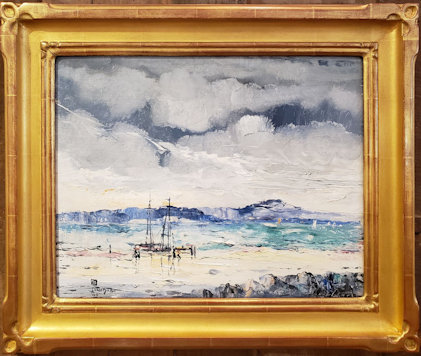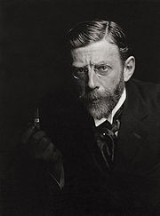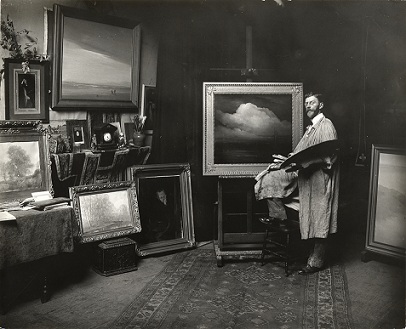|
|
|
|
Item #AT-0433Leon Dabo, NA (1864-1960) "Fishing Boat: Saint Tropez, No. 14"
|
|
|
|
|
Description: Fishing Boat: Saint Tropez, No. 14 aka Etude (Two Sailboats Near Beach)
Oil on Board
15" x 18" unframed
19.25 x 23.25" framed
Signed and dated 1940 lower left
On Verso:
Sullivan Goss An American Gallery label
Signed Leon Dabo 1940 with Monogram Stamp
Estate Sticker 399
Hand carved Gilt Frame by Carleton Kirkegaard, Santa Barbara.
Provenance:
Estate of Leon Dabo
Ruth Green
David Hollander
Robert Di Domizio
Sullivan Goss
Stillwell House Fine Arts & Antiques
Exhibition:
March 31, 1941, "When I Last Saw France", Ferargil Galleries, 63rd st 57th St., New York, NY, Fishing Boat: Saint Tropez, No. 14
|

|
|
|
|
LEON DABO: When I Last Saw France
Dabo's first major exhibition after slipping out of Europe
in September of 1940 was held from March 31 to April
13, 1941 at Ferargil Gallery in Manhattan. It was called
LEON DABO: When I Last Saw France. Writing in New
York American, Malcom Vaughan wrote:
On these walls are the latest paintings of France to
be rescued from the talons of war. Some were painted
on the Channel coast before the bombs disfigured
it; some reflect the last free-hearted days of sunny
Provence and some were painted in Paris after the
city had suffered defeat.
|
![]()
|
|
|
|
The Art Digest article covering the exhibition was
titled "Leon Dabo Was There When Paris Died." It
noted that, "The last time Leon Dabo saw Paris it was
literally in the hands of the devil..." The exhibition was
widely covered, largely in similarly stirring language.
Dabo had once again enlisted in a War effort, this
time as an artist. In December of 1941, a National
Art Council for Defense was formed with Dabo on
the Board. He also donated to the French Families
in England Fund of the American-French War Relief
charity. During the War Years, Leon Dabo produced
a number of pieces that were emblematic of French
culture. At 77, it was his way of serving.
* Essay by Jeremy Tessmer, " Leon Dabo En France Encor"
|
![]()
|
|
|
|
LEON DABO 1864-1960
Painter, muralist and lithographer, a distinguished artist known to museums, curators and collectors worldwide. An American artist born in France, Dabo’s active career in art extended over a period of 80 years. He painted both in New York and France between the two world wars. He studied with some of the most influential painters of his day, John La Farge, Puvis de Chavannes, and James Abbott McNeill Whistler.
Dabo’s first teacher in New York City was John La Farge [1835-1910] where he followed La Farge’s artistic philosophy, that art should embody “more than a mere representation of external appearances,” that views of nature should transcend the physical and appeal to ones emotion. La Farge is also credited with Dabo’s introduction to flower painting.
|

|
|
|
|
In his early years in Paris, Dabo was a protégé of the renowned painter and muralist Puvis de Chavannes [1824-1898] many of his early landscapes owes much to his mentor in muted tonality, and evoking a dreamy quiet mood. In 1888 Dabo settled in London where he associated with such artistic personalities as James McNeill Whistler, Walter Sickert, George Bernard Shaw, Alvin Langdon Coburn, among others. But it was James McNeill Whistler [1834-1903] who had a profound and lasting influence on Dabo’s art. He closely followed Whistler’s theory of “Art for Art’s sake,” showing the close relationship between the soft, tonal quality of color with the careful placement of composition into decorative and harmonious elements.
Dabo was involved with and participated in two of the major events in the American Art scene; the Independents of 1910, and the Armory Show of 1913.
|

|
|
|
|

|
His travels abroad between 1917-1920 as a member of the American financial Mission to the Allies, allowed him to meet other important artist’s of the day, and to study their work.
Dabo was commissioned by the Army’s Fourth Division under Major General Mark L. Hersey to execute five paintings depicting landscapes of historic sites during the first World War. Dabo continued to paint and exhibit in this country and Europe until his death in 1960, where he strove to realize new color sensations, mastering his use of light, texture and atmosphere.
His works are owned by over fourty museums in this country and abroad, among them;
The National Museum of American Art
Washington D.C. “Evening on the Hudson”
The Metropolitan Museum of Art, New York, “The Cloud”, “New York Harbor from the Jersey Shore“, “Marine”
Musee D’Orsay, Paris, France “Moore Park”
The Musee de Lourve, Paris, France, “Citadel”.
|
|
|
|
|
|
|
|
|
|
|
|
|
|
|
|
|
|
|
|
|
|
|
|
|
|
|
|
|
|
|
|
|
|
|
|
|
|
|
|
|
|
|
|
|
|
|
|
|
|
|
|

